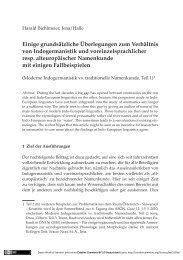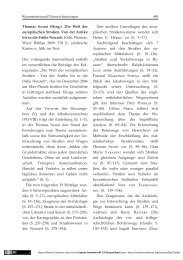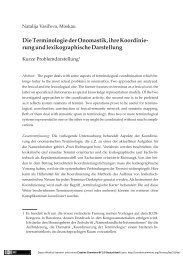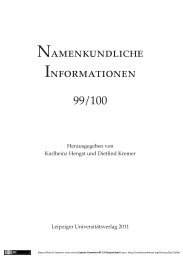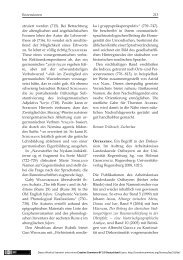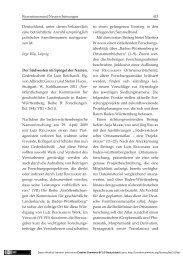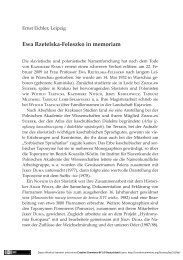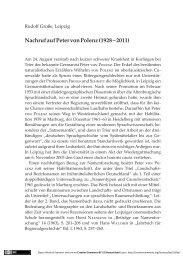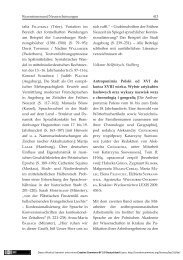Proper Names in the Light of Theoretical Onomastics
Proper Names in the Light of Theoretical Onomastics
Proper Names in the Light of Theoretical Onomastics
Create successful ePaper yourself
Turn your PDF publications into a flip-book with our unique Google optimized e-Paper software.
<strong>Proper</strong> <strong>Names</strong> In <strong>the</strong> <strong>Light</strong> <strong>of</strong> <strong>Theoretical</strong> <strong>Onomastics</strong>99<strong>of</strong> computers (ma<strong>in</strong>ly <strong>in</strong> process<strong>in</strong>g data sets numbered <strong>in</strong> hundreds <strong>of</strong>thousands, even millions). A different view is evident <strong>in</strong> questions suchas: does onymy possess any <strong>in</strong>tegrat<strong>in</strong>g organisational pr<strong>in</strong>ciple; why isa proper name a l<strong>in</strong>guistic sign sui generis; what is its content and formalstructure; why is it necessary to dist<strong>in</strong>guish between content and (ony mic)mean<strong>in</strong>g <strong>of</strong> a proper name; why is it necessary to differentiate betweentwo groups with<strong>in</strong> a set <strong>of</strong> <strong>in</strong>formational elements <strong>in</strong> knowledge <strong>of</strong> anonymic object; when th<strong>in</strong>k<strong>in</strong>g about <strong>the</strong> nature <strong>of</strong> an onymic sign, what is<strong>in</strong>dicative <strong>of</strong> <strong>the</strong> fact that its content (more precisely its onymic features)and form are <strong>in</strong>terrelated; how is <strong>the</strong> transition from <strong>the</strong> first nam<strong>in</strong>g tob<strong>in</strong>ary nam<strong>in</strong>g anthroponymic system <strong>in</strong> deep structure <strong>in</strong>dicated; how todescribe <strong>the</strong> microsystem <strong>of</strong> liv<strong>in</strong>g proper names; are citizen names andethnic names categorised as appellatives or propria; is <strong>the</strong> description <strong>of</strong>superficial onymic phenomena <strong>the</strong> f<strong>in</strong>al aim <strong>of</strong> <strong>the</strong> research; what are <strong>the</strong>outcomes <strong>of</strong> modell<strong>in</strong>g <strong>of</strong> pr<strong>in</strong>ciples <strong>of</strong> nam<strong>in</strong>g and process<strong>in</strong>g data by<strong>the</strong> computer technique, etc. etc. Or : if <strong>the</strong> same form Mart<strong>in</strong> can be a firstname, surname, liv<strong>in</strong>g family name, <strong>the</strong> name <strong>of</strong> a town, boat, recreationfacility, animal, book and so on, <strong>in</strong> <strong>the</strong>se cases is it solely a different referentor beh<strong>in</strong>d a different identification are <strong>the</strong>re different (specificallyonymic) elements <strong>of</strong> content which are also reflected <strong>in</strong> <strong>the</strong> formal aspect<strong>of</strong> <strong>the</strong> name; what is <strong>the</strong> implication <strong>of</strong> this fact <strong>in</strong> <strong>the</strong> valuation <strong>of</strong> <strong>the</strong>onymic sign ? The answer to <strong>the</strong>se and similar questions is related to <strong>the</strong><strong>the</strong>oretical basis which, even <strong>in</strong> <strong>the</strong> current stage <strong>of</strong> onomastics, are notuniform. The concepts and explanations which follow fur<strong>the</strong>r <strong>in</strong> <strong>the</strong> textstem ma<strong>in</strong>ly from <strong>the</strong> analysis <strong>of</strong> personal names which, due to <strong>the</strong>ir abundance,<strong>in</strong>ternal variety and social determ<strong>in</strong>ation, provide suitable materialfor <strong>the</strong>oretical and methodological generalisation. The answer I formulate<strong>in</strong> <strong>the</strong> follow<strong>in</strong>g chapters <strong>of</strong> this contribution is a summary and draft <strong>of</strong> aconcept which I have arrived at <strong>in</strong> my studies and th<strong>in</strong>k<strong>in</strong>g to date.2. 1 The l<strong>in</strong>guistic and onomastic status <strong>of</strong> proper namesThe dual status <strong>of</strong> <strong>the</strong> proper name <strong>in</strong> language (<strong>the</strong> name as an element<strong>of</strong> <strong>the</strong> vocabulary <strong>of</strong> a language and simultaneously an element <strong>of</strong> an onymicset) is a crucial start<strong>in</strong>g po<strong>in</strong>t <strong>in</strong> comprehend<strong>in</strong>g its special status and<strong>the</strong> valuation <strong>of</strong> proper names <strong>in</strong> a language. Nam<strong>in</strong>g <strong>in</strong>dividuals <strong>of</strong> <strong>the</strong>same species is a special case <strong>of</strong> nom<strong>in</strong>ation. It is <strong>the</strong> most detailed classification<strong>of</strong> real phenomena by language means which is <strong>in</strong>duced by so-



